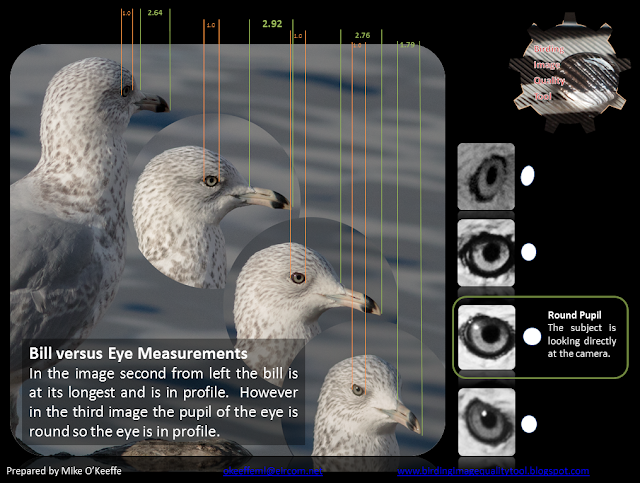It is within the subject of gestalt that I tackle the questions of bird size and shape in this blog.
Having drawn some rather pessimistic conclusions about the usefulness of Primary Projection as a measurement directly from photographs I find myself picking on another favourite form of comparative measurement, the Bill to Eye Ratio. This is the ratio of the width of the eye (front to back) and the length of the bill. As with primary projection typically this measurement is described in terms of a perfect side profile view. But, as with primary projection we are not dealing with a straightforward linear measurement and it can be difficult also to accurately find points to measure from because the bill base and occasionally eye can be partially obscured by feathering.
Typically birds have a conical skull shape, spherical at the rear, tapering towards the bill. The eyes sit in large spherical sockets and the bill protrudes from the tapered end of the skull. Vision in birds is very interesting in that more than 50% of birds have two fovea in the eye and so they have a choice of two centres of focus from which to view the world. Nonetheless most birds tend to look back at the observer or camera with one eye and, presumably mainly sharply focused with the fovea that is located directly opposite the pupil. To the camera the pupil looks perfectly spherical when birds are looking at the camera in this way, just as human eyes do when they are trained on the camera. So we might expect then that a perfectly round pupil indicates the bird's head is in perfect profile.
However when we compare images of the eye and bill at different angles to the camera we can see a problem with the bill to eye ratio.
When the bill is in profile the eye is not, and visa versa. As with the primary projection question we are trying to take measurements from a two dimensional projection of objects which are not directly comparable as they are not positioned along the same plane.
The same caveats apply to the bill to eye ratio as to primary projection:-
No.1 Bill to eye ratio is not a measurement as such.
No.2 Bill to eye ratio only makes sense when the bird is viewed in side profile. Determining what the side profile of the head is may be a matter for debate. The eye and bill are not necessarily in profile together.
No.3 Bill to eye ratio is unreliable and at best only an estimate.


No comments:
Post a Comment